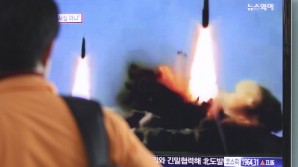During a speech at the Pentagon on March 15 2013 Secretary of Defense Chuck Hagel delivered the following remarks regarding the missile threat from North Korea:
“The United States has missile defense systems in place to protect us from limited Intercontinential Ballistic Missile (“ICBM”) attacks, but North Korea in particular has recently made advances in its capabilities and has engaged in a series of irresponsible and reckless provocations”, the Secretary said.
“Specifically, North Korea announced last month that it conducted its third nuclear test, and last April displayed what appears to be a road-mobile ICBM. It also used its Taepo Dong-2 missile to put a satellite in orbit, thus demonstrating progress in its development of long-range missile technology”, he said. “In order to bolster our protection of the homeland and stay ahead of this threat we are taking four steps.”
4-Step plan
“First, we will strengthen homeland missile defense by deploying 14 additional Ground-Based Interceptors (GBIs) at Ft. Greely, Alaska. That will increase the number of deployed Ground Based Interceptors from 30 to 44, including the four GBIs at Vandenberg Air Force Base in California. These additional GBIs will provide a nearly 50 percent increase in our missile defense capability. Second, with the support of the Japanese government, we are planning to deploy an additional radar in Japan. This second TPY-2 ortippy-tworadar will provide improved early warning and tracking of any missile launched from North Korea at the United States or Japan. Third, as directed by Congress, we are conducting Environmental Impact Studies for a potential additional GBI site in the United States. While the Administration has not made any decision on whether to proceed with an additional site, conducting Environmental Impact Studies will shorten the timeline for construction should that decision be made. And fourth, we are restructuring the SM-3 IIB program. As many of you know, we had planned to deploy the SM-3 IIB as part of the European Phased Adaptive Approach. The purpose was to add to the protection of the U.S. homeland already provided by our current GBIs against missile threats from the Middle East. The timeline for deploying this program had been delayed to at least 2022 due to cuts in congressional funding. Meanwhile, the threat matures. By shifting resources from this lagging program to fund the additional GBIs as well as advanced kill vehicle technology that will improve the performance of the GBI and other versions of the SM-3 interceptor, we will be able to add protection against missiles from Iran sooner while also providing additional protection against the North Korean threat”, the secretary explained.
The secretary also underscored DOD’s commitment to the expanded North Atlantic Treaty Organization (NATO) missile defense program:
“Let me emphasize the strong and continued commitment of the United States to NATO missile defense. That commitment remains ironclad. The missile deployments the United States is making in phases one through three of the European Phased Adaptive Approach, including sites in Poland and Romania, will still be able to provide coverage of all European NATO territory as planned by 2018”, Hagel said (source: Pentagon http://www.defense.gov/speeches/speech.aspx?speechid=1759).

